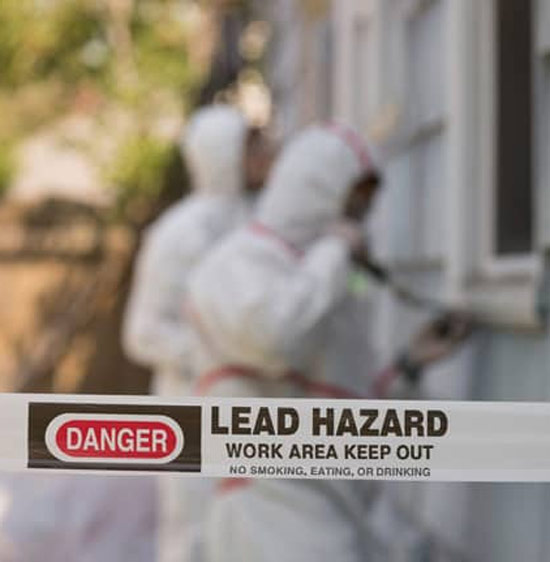Lead Paint Removal Service-- NYC's Trusted Solutions for Lead Safety
Lead Paint Removal Service-- NYC's Trusted Solutions for Lead Safety
Blog Article
Step-by-Step Refine for Effective Lead Offense Removal
Following this, adherence to federal and state policies is critical to creating an efficient removal plan. The real remediation calls for knowledgeable workers to apply these strategies while strictly complying with safety methods. What happens after the remediation is completed?

Discovery and Evaluation
Discovery and assessment are vital steps in the removal of lead offenses. To ensure an efficient remediation process, it is necessary to perform a complete assessment of the setting where possible lead direct exposure exists.
This consists of assessing the degree and seriousness of contamination, as well as recognizing populations at risk, specifically children and pregnant women. The collected information ought to be carefully documented to support the advancement of a reliable removal technique.
Additionally, it is vital to prioritize areas with the highest degree of contamination and those that position the best health and wellness risks. Effective interaction with stakeholders, consisting of homeowner, residents, and public health officials, is essential for making certain that all events are informed regarding the findings and the subsequent steps required for remediation. This initial discovery and analysis phase prepares for a successful lead infraction remediation procedure.

Lawful and Regulative Compliance
Browsing the landscape of legal and regulatory conformity is an essential element of successful lead violation removal. Compliance makes certain not just the safety of affected populaces but additionally the reputation and legal standing of the company in charge of remediation. Regulations governing lead contamination are complex, encompassing government, state, and neighborhood regulations. At the government level, the Epa (EPA) sets rigorous criteria under the Poisonous Compounds Control Act (TSCA) and the Lead-Based Paint Renovation, Fixing, and Paint Guideline (RRP Policy)
This entails careful documentation of all remediation activities to show conformity. Failure to stick to these guidelines can result in extreme charges, including significant penalties, lawful activity, and reputational damage.
Involving lawful specialists focused on ecological law can facilitate navigating these intricacies. Normal training and accreditation for all workers entailed in the remediation process are also required to make sure adherence to safety and regulative requirements. By prioritizing legal and regulative conformity, organizations can successfully reduce threats and accomplish a successful remediation result.
Planning the Remediation
Properly preparing the removal of lead infractions starts with a detailed analysis of the infected website. This first evaluation needs to include a comprehensive website investigation to recognize the degree and focus of lead contamination. Comprehensive sampling and laboratory evaluation are vital to create an accurate contamination account. This data-driven approach makes sure that remediation efforts are properly targeted and effective.
When the contamination is mapped, a threat analysis should be performed to examine prospective health dangers to humans her comment is here and the environment. Lead Violation Removal in NYC. This assessment needs to consider aspects such as direct exposure pathways, population susceptability, and environmental effects. The insights gathered will form the basis for choosing an appropriate remediation technique
Subsequently, setting clear, achievable purposes for the remediation job is crucial. These goals ought to line up with governing standards and stakeholder expectations to guarantee compliance and neighborhood acceptance. Establishing a thorough remediation strategy that outlines methods, timelines, and source appropriation will certainly assist in an organized approach to the cleanup procedure.
In addition, it is necessary to engage with stakeholders early and preserve clear interaction throughout the preparation phase. This consists of informing local areas, obtaining essential authorizations, and coordinating with regulative agencies to make sure all legal and step-by-step requirements are met. A well-crafted removal strategy not only deals with the contamination efficiently however also constructs count on and cooperation amongst all celebrations entailed.
Executing the Removal
With a well-structured removal plan in place, the focus shifts to the actual implementation of the removal tasks. This phase entails activating the necessary resources, including competent personnel, specific equipment, and high-quality products. Begin by clearly delineating duties and responsibilities to ensure responsibility and smooth sychronisation amongst team participants.
The preliminary action in execution is to protect the site. This consists of establishing containment locations to stop lead dirt and debris from dispersing, as well as using air filtering systems to keep air top quality. Next, continue with the removal of lead-based materials. Make use of methods such as wet scuffing, chemical stripping, or encapsulation, relying on the severity and place of the contamination. It is vital to stick to safety methods, including making use of individual safety equipment (PPE) and proper disposal of harmful products.
Throughout the remediation process, conduct regular inspections and air quality keeping track of to make sure conformity with governing criteria. Reliable interaction with stakeholders, consisting of homeowner and occupants, is essential to keep them notified of progress and any type of unanticipated developments. By meticulously complying with these steps, the remediation activities can be implemented efficiently and successfully, eventually mitigating lead dangers.
Post-Remediation Approaches
Post-remediation techniques play a critical function in guaranteeing the lasting success of lead infraction remediation initiatives. These approaches incorporate ongoing monitoring, upkeep, and area education to protect against future lead exposure and ensure right here a secure atmosphere.
First, routine monitoring is important. This involves routine testing of the previously influenced locations to guarantee that lead degrees stay my website within safe restrictions. Property proprietors must establish a timetable for these tests, preferably in partnership with qualified environmental professionals.

Third, informing the area plays an essential function in sustaining the advantages of remediation. Citizens and property supervisors ought to be educated about the threats of lead exposure and the very best practices for maintaining a lead-safe setting. Workshops, informational handouts, and community meetings can be efficient devices for distributing this details.
Final Thought
Effective lead infraction remediation calls for a comprehensive, methodical approach encompassing detection and evaluation of contamination, adherence to lawful and governing standards, meticulous preparation, and effective implementation of removal initiatives. Post-remediation techniques, consisting of continual monitoring and neighborhood education and learning, are necessary to maintain a lead-safe setting. Cooperation with ecological professionals guarantees recurring conformity and protection of public wellness. This methodical procedure emphasizes the importance of thoroughness and watchfulness in attending to and alleviating lead contamination.
Report this page